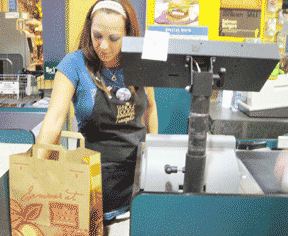 |
|||||||||||
|
|||||||||||
|
|||||||||||
Life Beyond Plastic
… Bags, That IsWhole Foods Annapolis bids adieu to an old standbyby Carrie MadrenNext time you go through the checkout line at Whole Foods, with your organic mangos and kashi, you won’t hear paper or plastic? at the end of the conveyor belt. You’re more likely to hear Did you bring a reusable bag today? That’s because starting July 6, Whole Foods at Annapolis Harbour Center took the plunge to stop offering plastic checkout bags. The goal, said Whole Foods spokeswoman Amy Chase, is to help stop plastic bags from ending up in community spaces, waterways and the ocean. “Bags are embedded in trees and clogging local stormwater drains,” Chase said. “Others are thrown into local landfills where they will remain for many years before photo degrading and releasing toxins back into the environment.” Each week, the store typically went through some 32,000 plastic bags, said Whole Foods team leader Andy Friedman. Their average shopper used some 192 bags a year. Nationwide, less than one percent of the 14 million plastic bags produced in the United States are recycled each year. So Whole Foods Annapolis decided to get out of the plastic bag business.
“We’re moving into an era of making the choice [of using plastic] more transparent to customers,” said Sarah Kenney, marketing director for the Mid-Atlantic region. “Unless you confront your own usage, it sneaks up on you. If everyone takes one step closer to that consciousness to reduce, not just reuse,” she said, then we’ll save our resources and enjoy a cleaner environment. Other changes throughout regional Whole Foods stores include switching from clear plastic containers at the salad bar to compostable, rectangular tubs made from bulrush — resulting in a material similar to cardboard egg cartons. Once a customer has gathered her groceries, she can ask for Whole Foods’ paper bags, purchase a reusable bag or tote in her own cloth sacks. For $1 a piece, the store sells nifty reusable bags — printed up like colorful old-time food sacks — that hold up to 50 pounds of groceries. The store has sold or given away some 20,000 of these bags, Kenney said. Bring your own bag, Friedman said, and “we’ll offer a five-cent credit for every reusable bag used.” Friedman and his staff made the decision in the first week of July, but instead of advertising the plastic cutoff right away, they stopped ordering. “We needed to make sure,” he said. He talked his team through the decision and how it would affect customers. But going beyond that, the store now offers rubberbands for strawberries and other foods that need extra support. Cashiers don’t ask if a customer wants paper or plastic, but if they brought a reusable tote. “Once we got the pieces in place, the cat’s out of the bag, pun intended,” Friedman said. You’ll still find plastic bags at the produce section, for now. The store is looking into testing biodegradable bags for protecting produce in the future. Ice cream and other condensing items have always gone into extra-thick paper bags. Though customers get a good deal, the switch will cost the store more money. “Paper bags cost more money than plastic, but this is something that we’re passionate about,” Friedman said. The bold move arrived the same week that Councilman Sam Shropshire introduced a measure to ban plastic bag use within Annapolis city limits. Though Shropshire didn’t personally sway the store’s decision, said Friedman, the impending law moved the store’s own initiative forward. “We decided to be proactive about it and not wait for legislation to happen,” Friedman said. “We’d been talking about it for a long time as a way to generate less trash, and this was a nudge.” |
|||||||||||
|
|||||||||||
|
|
|||||||||||
|
© COPYRIGHT 2007 by New Bay Enterprises, Inc. All rights reserved. |
|||||||||||


